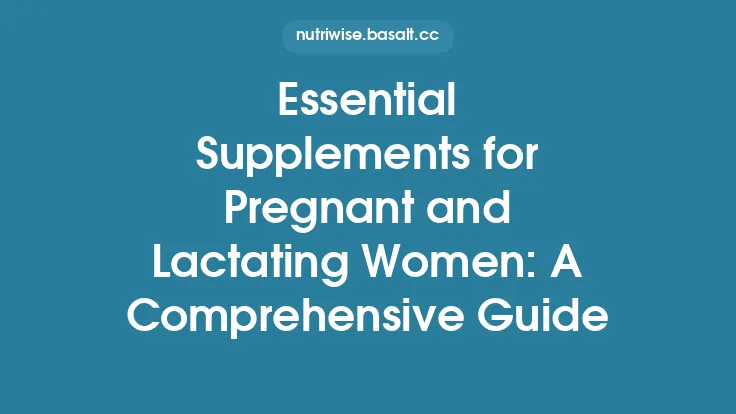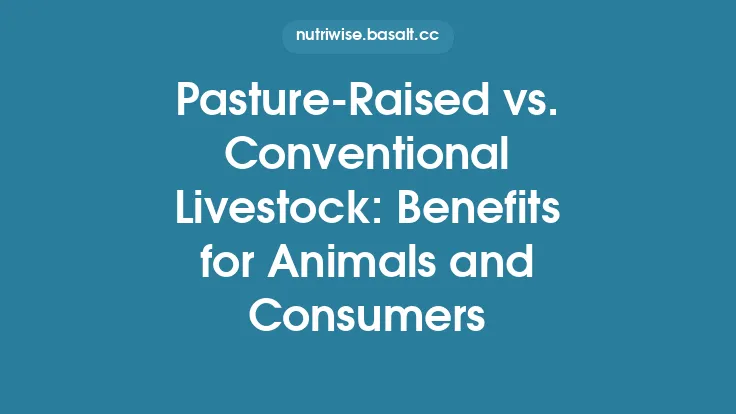Front‑of‑Package (FOP) labeling has become one of the most visible tools for translating complex nutrition science into actionable information at the point of purchase. By placing concise, standardized nutrition cues directly on the front of a product’s packaging, policymakers aim to empower consumers to make healthier choices while encouraging manufacturers to reformulate products toward better nutrient profiles. This guide synthesizes the current evidence base, design considerations, policy levers, and implementation pathways that are relevant for both consumers seeking to interpret labels and policymakers tasked with establishing effective regulatory regimes.
Why Front‑of‑Package Labels Matter
Evidence of Impact
Systematic reviews of randomized controlled trials and natural experiments consistently show that well‑designed FOP labels can shift purchasing patterns toward lower‑energy, lower‑sugar, lower‑sodium, and higher‑fiber options. Meta‑analyses report average reductions of 5–10 % in the purchase of products with unfavorable nutrient profiles when a salient FOP system is present.
Behavioral Mechanisms
FOP labels operate through several cognitive pathways:
- Simplification – Reducing the dimensionality of nutrition information from a dense Nutrition Facts panel to a few visual cues lowers the mental effort required for decision‑making.
- Salience – Color, shape, and size draw attention in a crowded shelf environment, increasing the likelihood that the label is noticed before the product is selected.
- Heuristic Processing – Consumers often rely on “quick rules of thumb” (e.g., “green means healthy”) rather than detailed analysis; well‑calibrated heuristics can guide healthier choices.
- Social Norms – When a label is applied universally, it creates a normative expectation that healthier formulations are the default.
Public‑Health Rationale
From a population‑level perspective, modest shifts in average dietary intake can translate into substantial reductions in chronic disease burden. Modeling studies suggest that a 5 % reduction in average sodium intake, achievable through FOP‑driven reformulation, could prevent up to 30,000 cardiovascular deaths annually in a mid‑size country.
Key Design Principles
| Principle | Description | Practical Example |
|---|---|---|
| Clarity | Information must be legible, unambiguous, and interpretable without external references. | Use a single, large “traffic‑light” symbol with clear color coding. |
| Consistency | Uniform application across product categories prevents consumer confusion. | Apply the same nutrient thresholds for all ready‑to‑eat meals. |
| Scientific Rigor | Thresholds and scoring algorithms should be based on peer‑reviewed nutrient profiling models. | Adopt the WHO Nutrient Profile Model for processed foods. |
| Actionability | The label should suggest a clear course of action (e.g., “choose this” vs. “avoid this”). | A “high‑fiber” badge that encourages selection of whole‑grain products. |
| Cultural Relevance | Visual cues and language must align with local dietary norms and literacy levels. | Use culturally familiar symbols (e.g., a leaf for “plant‑based”). |
| Non‑Deceptiveness | Avoid claims that could mislead, such as “low‑fat” on a product high in added sugars. | Require a complementary “sugar‑content” indicator when “low‑fat” is displayed. |
Visual Formats
- Interpretive Symbols (e.g., traffic‑light, star rating) convey overall healthfulness.
- Nutrient‑Specific Icons (e.g., “high‑protein”, “low‑sodium”) highlight particular attributes.
- Hybrid Systems combine a summary score with key nutrient call‑outs, balancing breadth and depth.
Size and Placement
Regulations typically mandate a minimum size (e.g., 2 cm²) and a location that is visible when the product is displayed on shelves (e.g., top‑right quadrant). Empirical eye‑tracking studies show that placement at eye level maximizes fixation time.
Scientific Basis for Label Content
Nutrient Profiling Models
- WHO Nutrient Profile Model (NPM) – Sets category‑specific thresholds for sugar, sodium, saturated fat, and total fat. Products exceeding any threshold receive a “less healthy” designation.
- Nutri‑Score – Calculates a composite score from -15 (most favorable) to +40 (least favorable) based on energy, sugars, saturated fat, sodium (negative points) and protein, fiber, fruit/vegetable/nut content (positive points).
- Health Star Rating (HSR) – Uses a 0.5‑star incremental scale (0.5 to 5 stars) derived from a similar algorithm to Nutri‑Score but with region‑specific weighting.
Policymakers must select a model that aligns with national dietary guidelines and the regulatory capacity to enforce it. The chosen model should be transparent, reproducible, and periodically updated to reflect emerging evidence (e.g., new data on added sugars).
Threshold Determination
- Evidence‑Based Cut‑Points – Derived from dose‑response meta‑analyses linking nutrient intake to disease risk. For sodium, a threshold of ≤ 120 mg per 100 g is commonly used for “low‑sodium” claims.
- Category Adjustments – Certain foods (e.g., cheese) naturally contain higher saturated fat; thresholds are calibrated to avoid penalizing traditional products while still encouraging improvement.
- Upper Limits for Additives – Some FOP systems incorporate limits for added sugars, non‑nutritive sweeteners, or trans‑fat, reflecting their distinct health implications.
Regulatory Frameworks and Policy Options
- Mandatory vs. Voluntary
- *Mandatory* schemes ensure universal coverage and level the playing field, reducing “label‑shopping” by manufacturers.
- *Voluntary* approaches can serve as pilots, allowing industry to test formats before full adoption.
- Prescriptive vs. Performance‑Based
- *Prescriptive* regulations dictate exact label design (color, shape, wording).
- *Performance‑based* rules set outcome criteria (e.g., “labels must enable consumers to identify products with ≤ 5 g added sugar per serving”) and leave design to manufacturers, fostering innovation.
- Compliance Mechanisms
- Pre‑Market Approval – Labels reviewed before product launch.
- Post‑Market Audits – Random sampling of retail shelves.
- Penalties – Graduated fines, product recalls, or public disclosure of non‑compliant brands.
- Stakeholder Involvement
- Multi‑sector advisory committees (public health experts, consumer groups, industry) can co‑design standards, enhancing legitimacy and feasibility.
- International Harmonization
- Aligning national FOP regulations with Codex Alimentarius or regional trade agreements reduces barriers for cross‑border food trade and simplifies compliance for multinational manufacturers.
Implementation Strategies for Governments
Step 1: Evidence Synthesis and Policy Design
- Conduct a systematic review of existing FOP models and local dietary data.
- Model potential health impact using microsimulation tools (e.g., PRIME, IMPACT).
Step 2: Pilot Testing
- Select a representative product set across major categories.
- Deploy multiple label prototypes in a controlled retail environment.
- Measure outcomes: label noticeability, comprehension, purchase intent, and actual sales.
Step 3: Legislative Drafting
- Translate pilot findings into statutory language.
- Include clear definitions (e.g., “added sugars”, “whole‑grain”) and reference nutrient profiling methodology.
Step 4: Capacity Building
- Train food safety inspectors on label verification procedures.
- Develop an online portal for manufacturers to submit label files for pre‑approval.
Step 5: Public Roll‑Out
- Set a realistic compliance timeline (e.g., 12 months for existing products, 6 months for new launches).
- Provide a transition grace period with technical assistance.
Step 6: Ongoing Surveillance
- Integrate label data into national nutrition monitoring systems.
- Use point‑of‑sale scanner data to track shifts in product composition and consumer purchasing.
Consumer Education and Behavior Change
Multichannel Communication
- Mass Media Campaigns – Short videos explaining the meaning of each label element.
- In‑Store Materials – Shelf‑talkers and QR codes linking to detailed nutrition information.
- Digital Tools – Mobile apps that scan the FOP label and provide personalized recommendations.
Literacy Considerations
- Use plain language and pictograms to reach low‑literacy populations.
- Conduct focus groups to test comprehension across age, gender, and socioeconomic groups.
Behavioral Nudges
- Pair FOP labels with “healthy checkout” prompts (e.g., “You have 2 healthier items in your cart”).
- Offer loyalty points for purchasing products that meet “high‑health” criteria.
Feedback Loops
- Provide consumers with periodic summaries of their purchasing patterns (e.g., “Last month you bought 30 % fewer high‑sugar snacks”).
- Encourage self‑monitoring, which has been shown to reinforce healthier choices.
Monitoring, Evaluation, and Continuous Improvement
Key Performance Indicators (KPIs)
- Label Adoption Rate – Percentage of packaged foods displaying the mandated FOP label.
- Consumer Awareness – Proportion of shoppers who can correctly interpret the label (survey‑based).
- Purchasing Shifts – Change in sales volume of “high‑health” vs. “low‑health” products (retail scanner data).
- Product Reformulation – Number of products that improve their nutrient profile to achieve a more favorable label rating.
Data Sources
- Retail sales databases, national nutrition surveys, industry‑submitted label registries, and consumer panel studies.
Evaluation Designs
- Interrupted Time Series – Assess trends before and after label implementation.
- Difference‑in‑Differences – Compare regions with mandatory labeling to control regions without.
- Qualitative Assessments – Interviews with manufacturers and retailers to identify implementation barriers.
Iterative Updates
- Review nutrient thresholds every 3–5 years in line with updated dietary guidelines.
- Incorporate emerging scientific evidence (e.g., new limits for added fructose) into the profiling algorithm.
Challenges and Mitigation Strategies
| Challenge | Potential Impact | Mitigation |
|---|---|---|
| Industry Resistance | Delayed adoption, legal challenges | Early stakeholder engagement; phased compliance timelines; incentives for early adopters (e.g., tax credits). |
| Consumer Misinterpretation | Over‑reliance on single nutrients, “health halo” effect | Complementary education campaigns; require balanced labeling (e.g., both “low‑sugar” and “high‑sodium” warnings when applicable). |
| Label Fatigue | Diminished attention over time | Periodic redesigns; rotating supplemental icons to maintain novelty. |
| Data Quality for Nutrient Profiling | Inaccurate thresholds leading to misclassification | Mandate third‑party laboratory verification; use standardized analytical methods. |
| Cross‑Border Trade Issues | Inconsistent labeling across markets | Align with regional standards; provide equivalence tables for foreign products. |
Future Directions and Emerging Technologies
Digital Front‑of‑Package Labels
- Dynamic QR Codes that update nutrient information in real time (e.g., reflecting seasonal ingredient changes).
- Augmented Reality (AR) overlays that allow shoppers to view a product’s health score through a smartphone camera.
Machine‑Learning‑Driven Profiling
- Algorithms that integrate ingredient lists, processing level, and bioactive compounds to generate a more nuanced health score beyond traditional macro‑nutrient thresholds.
Personalized Nutrition Integration
- Linking FOP labels to individual health profiles (e.g., via electronic health records) to provide tailored recommendations at the point of purchase.
Sustainability Coupling
- While not the primary focus of this guide, emerging label systems are experimenting with combined health‑environment scores, offering a holistic view of product impact.
Global Learning Networks
- Platforms such as the International Network for Food and Nutrition Policy (INFNP) facilitate sharing of best practices, evaluation results, and technical resources across jurisdictions.
By grounding front‑of‑package labeling in robust scientific evidence, clear design standards, and transparent regulatory processes, policymakers can create an enduring public‑health tool that guides consumers toward healthier diets while incentivizing the food industry to innovate toward better nutrition. Continuous monitoring, consumer education, and adaptive policy mechanisms ensure that the system remains relevant as dietary science evolves and as market dynamics shift. Ultimately, a well‑implemented FOP labeling regime contributes to the broader goal of reducing diet‑related chronic disease and fostering a food environment where the healthier choice is also the easier choice.





